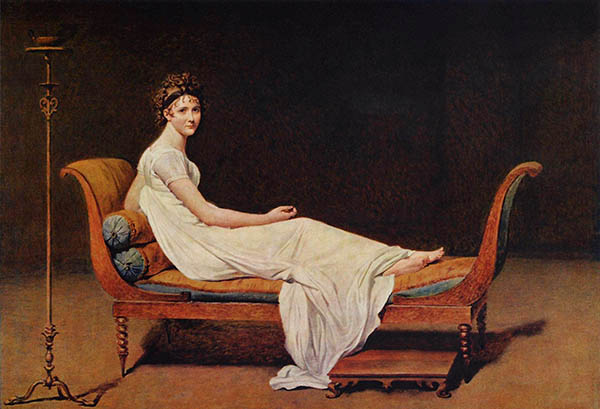Some Masterpieces from the Public Domain
Version 1.0, © 2009 by Dale Cotton, all rights reserved
David
Warning: clotheslessness below.
Wikipedia entry for Jacques-Louis David
Jacques-Louis David is another painter I was pretty much unaware of before this exploration. A quick reading of the Wikipedia entry on M. David paints the picture of a monster who painted like an angel. He was a principal actor in the witch hunt and blood-letting of the French revolution, along with Robespierre and Marat, then followed that up with a goodly dose of cheer-leading for Napoleon (which to me has the aspect of being sucked in by Hitler during the 1930s). He systematically used his gift with the paint brush to create propaganda for both causes. The Wikipedia article gives no indication that he ever regretted any of this in later years or ever came to see himself as a pawn of naive idealism.
Yet, for all that he was a superb artist, as the following four paintings amply attest.
Fig. 7-1 is a large portion, but not the entirety, of the full painting. If you're wondering how David was able to get away with this much skin, after the condemnation of Boucher and the Rococo movement – so am I. I also wonder whether the Helenic culture had access to any such blue pigment at that point in history, but I don't expect scholarship in the 1700s would have been aware of the anomaly. In any case, David gives us his take on the face that launched a thousand ships; I'd say it's pretty believable. ;) And as a bonus we get a portrait of Paris as a clownishly naive pretty boy that also works (at least for me):
I find it fascinating Jacques-Louis found time to paint what looks to be a commissioned portrait of someone fairly wealthy between signing death warrants; but actually the date 1800 probably puts it after the guillotine era and at the start of the Napoleon era.
The reproduction we have here is after restoration done at the Louvre to remove the yellowing of its surface coat of oil due to age. The fact that this distinction is being made by those distributing the JPEG (presumably the Louvre itself) is some assurance of colour accuracy (you can see both the yellowed and the restored versions here).
In this next painting, a pure propaganda piece of Napoleon (who apparently crossed the Alps on a mule, not a charger), we see stunningly photographic realism marred by crude pseudo-chisel work at the bottom. This reads BONAPARTE HANNIBAL KAROLUS MAGNUS AL-; in other words, Napoleon, Hannibal, and Charlemagne crossed the Alps here, tying the modern Napoleon to those legendary predecessors.
If you take a look at the Wikipedia page for this reproduction. You'll see three radically different versions. These are not different paintings but simply different scans of photographs with totally different colour results. Never having seen the original I went for the one you see below as being the most believable, requiring mainly just some desaturation to produce cast-free colour:

Fig. 7-3: Jacques-Louis David: The First Consul crossed the Alps at the Col du Grand St. Bernard, 1801
This last painting is the last or second last M. David ever painted. In the final phase of his life he had put politics behind him and was content just to live again with his wife. The story being told here is fairly blatant – the god of war allows the goddess of love to put aside his arms and armor. We might reasonably suppose M. David identifies with Mars, but if so this is anything but self-recrimination. More important to me is the painting technique I see here is beyond anything else I can think of up to that time. His earlier work was extremely realistic but this I have to look twice at this picture to reassure myself its not a colour photograph.
This may be due in part to the fact that the reproduction here is done by digital camera (Canon EOS 400). Technically, it was done at 1600 ISO (undoubtedly for very good reasons) and so suffers from colour mottling, that neither I nor the photographer have been able to entirely eliminate. Specifically, the very faint blotching from pink to greenish to yellowish in the skin tones are an artifact of the camera and not in the original.


